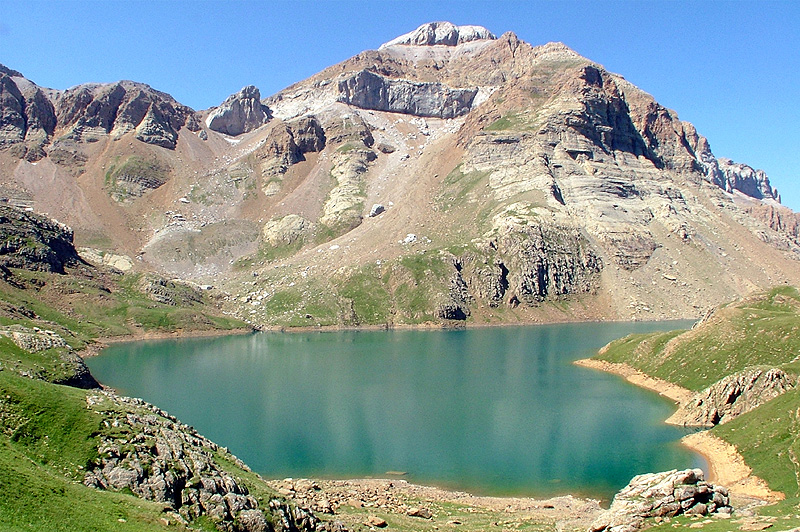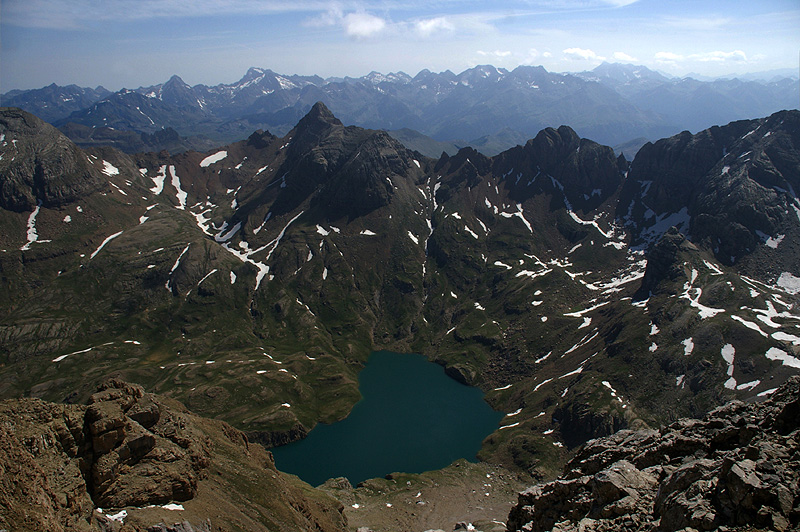Collarada and the Ip Canal
Collarada is the collosus of the Canfranc valley. It has an altitude of 2,886 metres and is the first peak in the western Pyrenees which is close to the mythical 3,000 metre mark. It therefore has a high alpine ecosystem and comes under the protection of a Habitat Directive (Sites of Community Importance), together with the nearby Ip Canal. These make up a total of 4,027 hectares of protected area which include the municipalities of Canfranc, Jaca, Sabiñanigo, Sallet de Gállego and Villanúa.
Collarada mountain does not form part of the main range but surges like a monumental bulge from the lower foothills. It harbours a great variety of landscapes and environments, from the subalpine pine and fir forests of its lower slopes to the alpine meadows of its higher reaches, which are snow-covered for the better part of the year. Geographical features formed by glaciers are also visible nearby, such as the cirque and tarn of Ip.
In some areas the landscape is arid and soulless, made up of limestone formations that contain deep fissures and large caves as a result of erosion by snow and water. The best known of these is the “Las Güixas” cave in Villanua, which has been the scene of human activity over many centuries. This series of limestone caves and fissures in the Collarada massif forms one of the most important examples of this type of formation in the entire Pyrenean range. With regard to fauna, it is worth noting some species of special interest such as the otter and several subspecies of bat.
Collarada mountain does not form part of the main range but surges like a monumental bulge from the lower foothills. It harbours a great variety of landscapes and environments, from the subalpine pine and fir forests of its lower slopes to the alpine meadows of its higher reaches, which are snow-covered for the better part of the year. Geographical features formed by glaciers are also visible nearby, such as the cirque and tarn of Ip.
In some areas the landscape is arid and soulless, made up of limestone formations that contain deep fissures and large caves as a result of erosion by snow and water. The best known of these is the “Las Güixas” cave in Villanua, which has been the scene of human activity over many centuries. This series of limestone caves and fissures in the Collarada massif forms one of the most important examples of this type of formation in the entire Pyrenean range. With regard to fauna, it is worth noting some species of special interest such as the otter and several subspecies of bat.
Also consult...
¤ Monuments
¤ Nature
¤ Villages
¤ Sport
¤ Tourist Offices
¤ Museums and Interpretation Centres
Guided tours 360°
Ciudadela de Jaca
[Español] · [Inglés]
Monasterio de San Juan de la Peña
[Español] · [Inglés]
Fort du Portalet
[Español] · [Francés]
follow us in...




 Comarca de La Jacetania
Comarca de La Jacetania
C/ Ferrocarril s/n 22700
JACA (Huesca)
T. (+34) 974 356 980
F. (+34) 974 355 241
:: Oficina de Turismo de JACA: 974 360 098
:: Oficina de Turismo de CANFRANC:
974 373 141
Site Map









